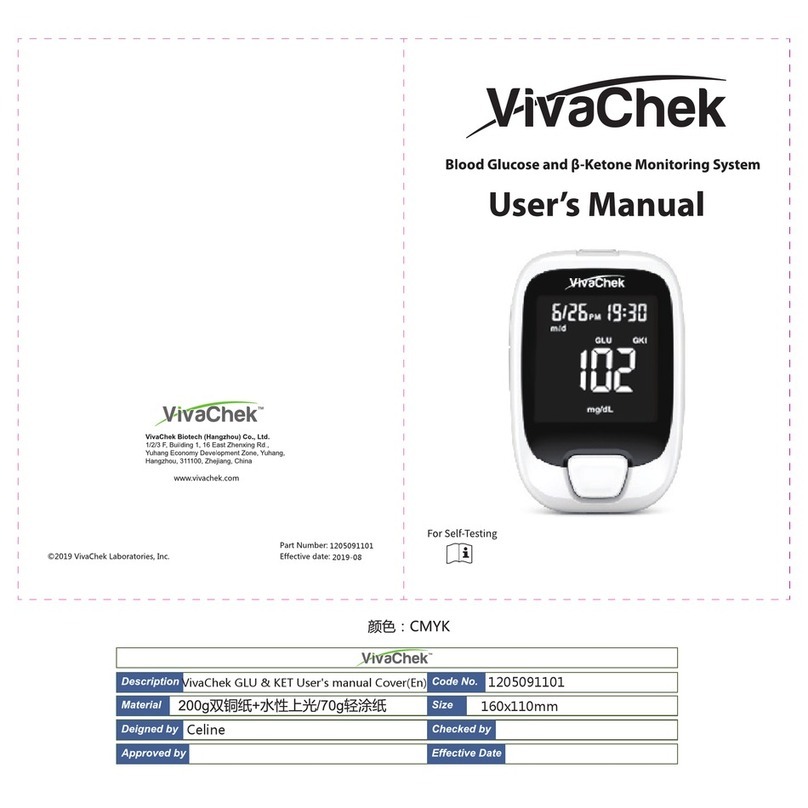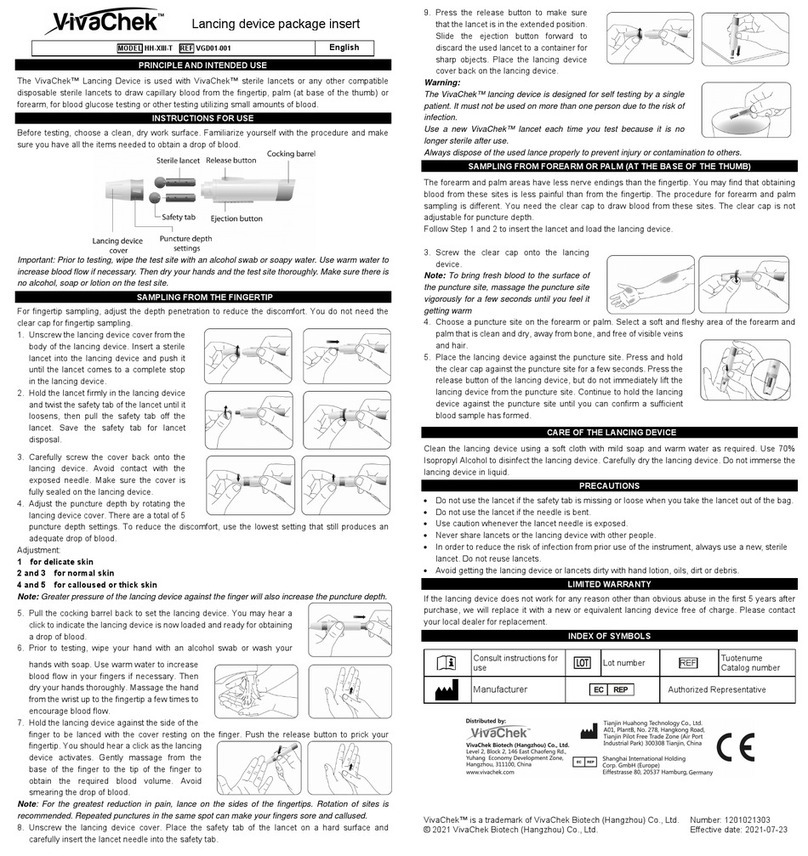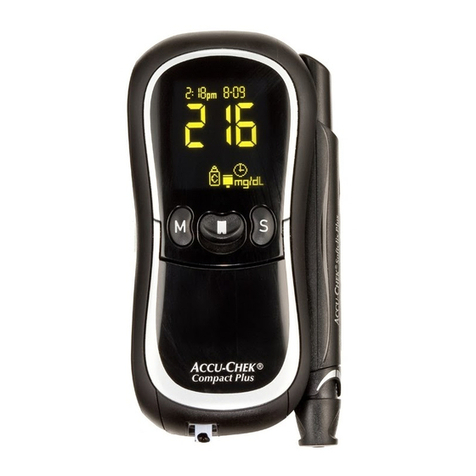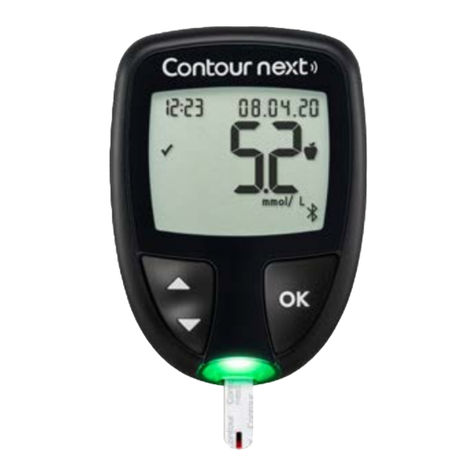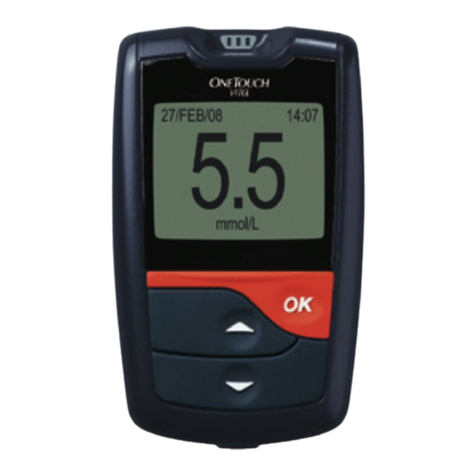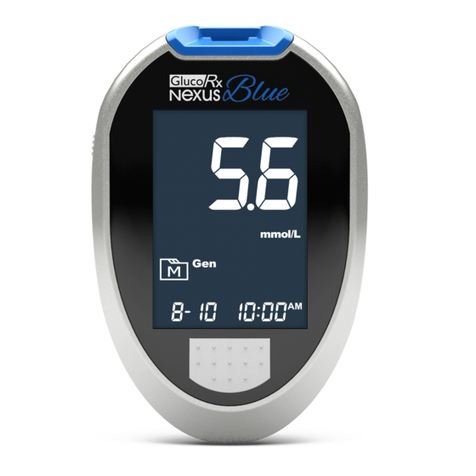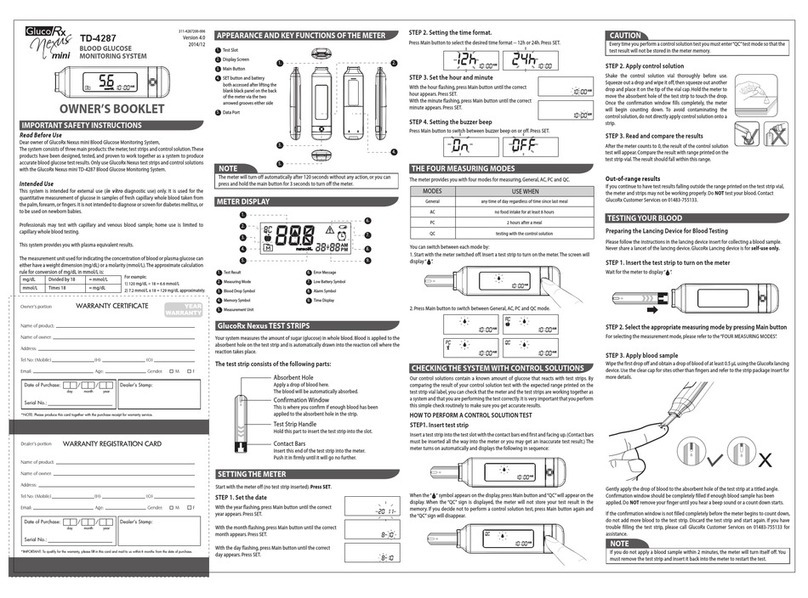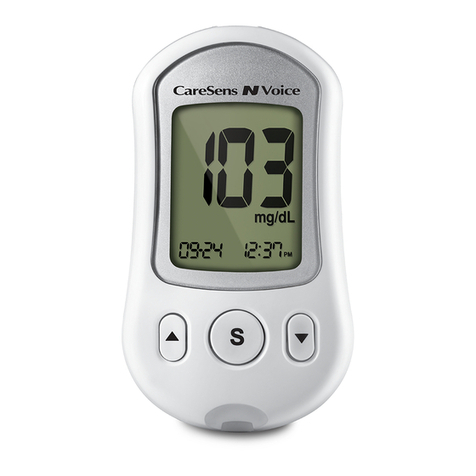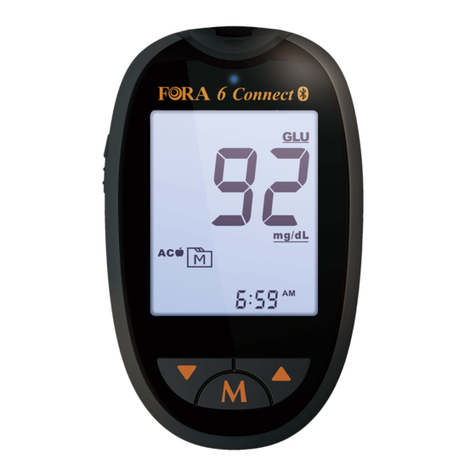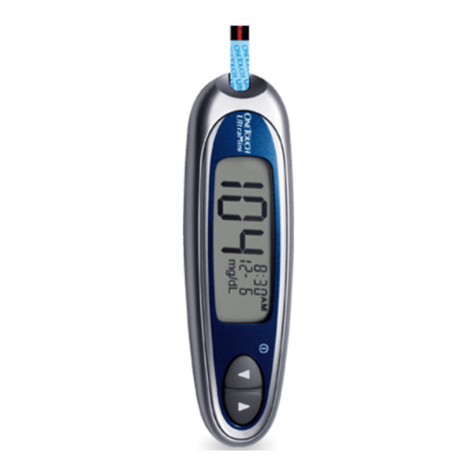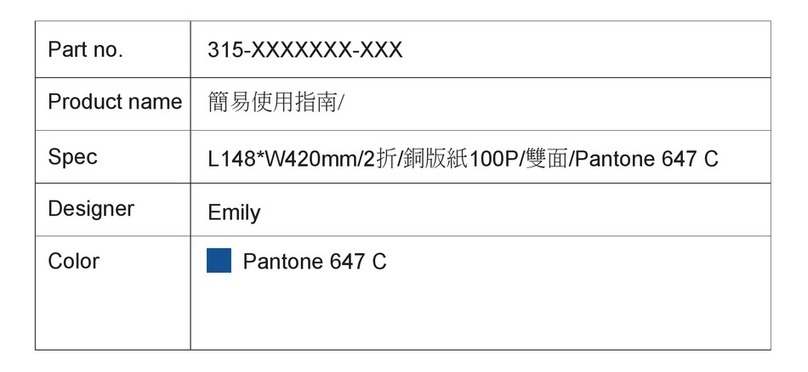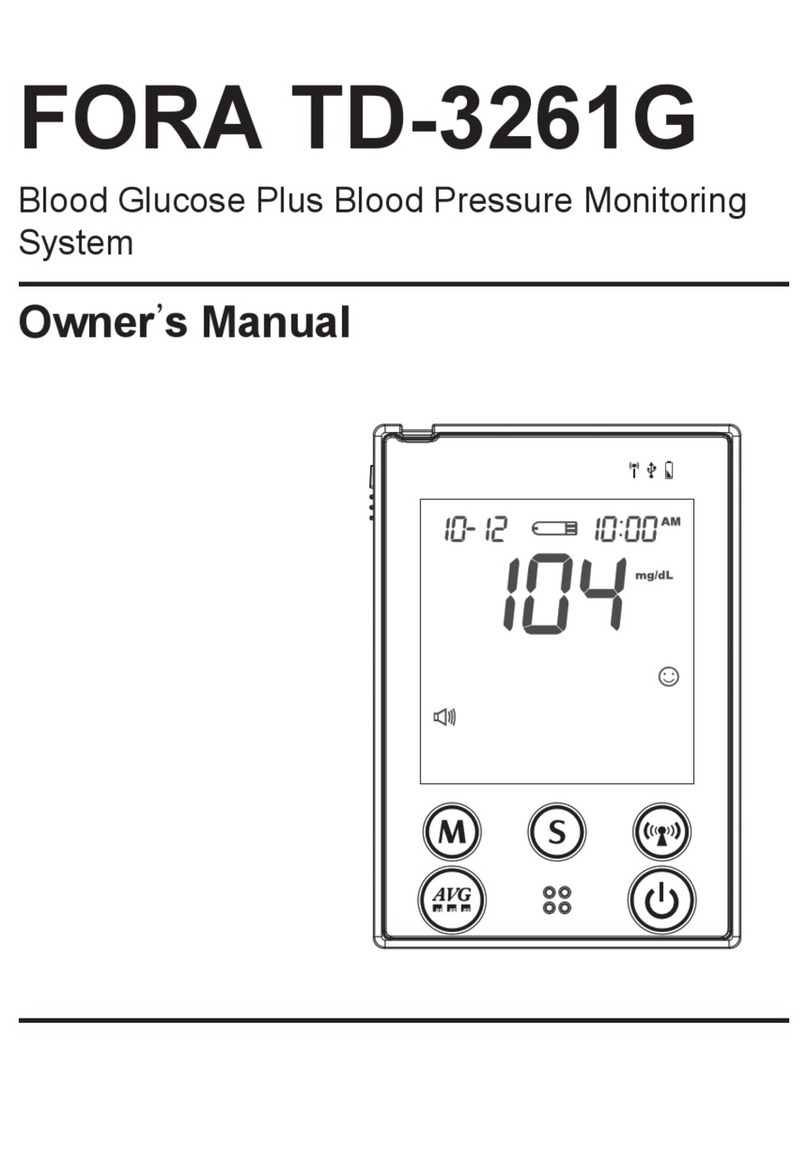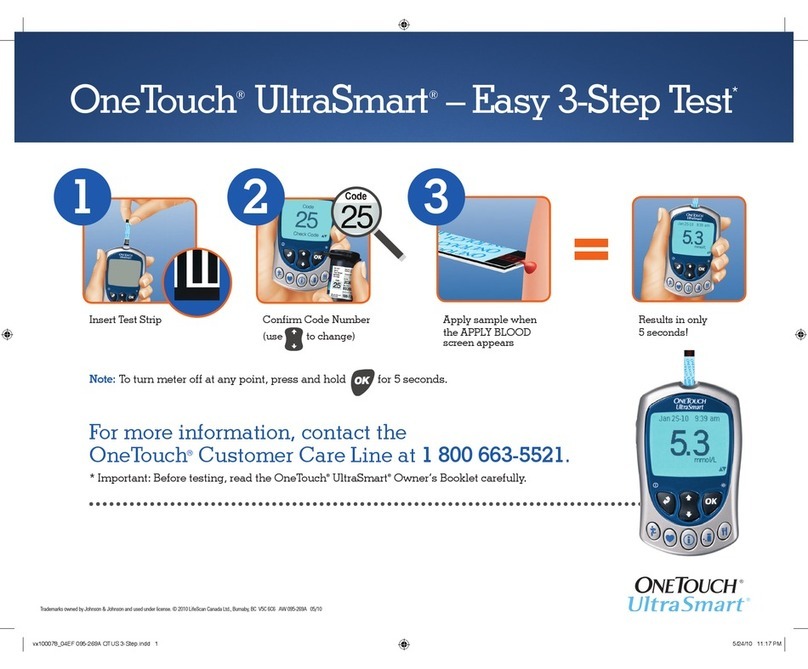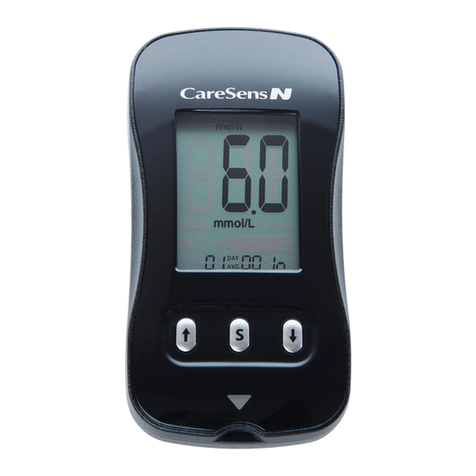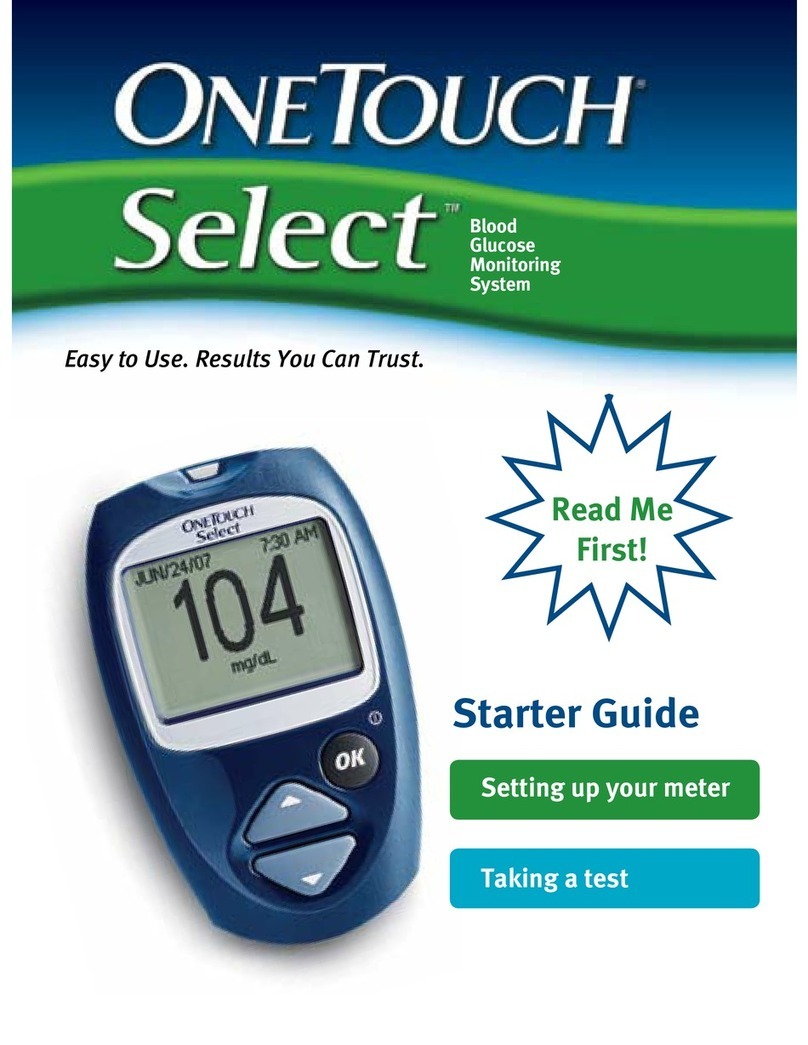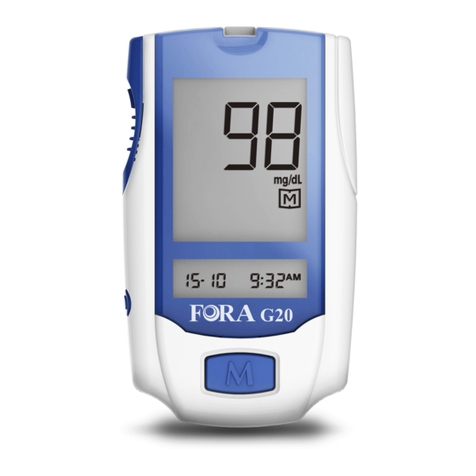VivaChek Fad Sync User manual

i
Blood Glucose Monitoring System
Dear VivaChek™ Fad Sync System User,
Thank you for choosing the VivaChek™ Fad Sync Blood Glucose Monitoring
System! VivaChek™ Fad Sync Blood Glucose Monitoring System is designed for
easy test of blood glucose and helps you keep blood glucose under control.
Read this User’s Manual carefully before you use your meter system. This manual
will help you to get comfortable using the VivaChek™ Fad Sync Blood Glucose
Monitoring System and get reliable test results. Please keep your User’s Manual in
a safe place; you may want to refer it in the future.
Thank you again for choosing the VivaChek™ Fad Sync System.
Intended Use and Principle
VivaChek™ Fad Sync Blood Glucose Monitoring System is comprised of the
VivaChek™ Fad Sync Blood Glucose Meter (VGM08) and the VivaChek™ Ino
Blood Glucose Test Strips (VGS01) and VivaChek™ Fad Blood Glucose Test
Strips (VGS02). The VivaChek™ Fad Sync Blood Glucose Monitoring System is
intended to quantitatively measure the glucose concentration in fresh capillary
whole blood samples drawn from the fingertips. It is intended for use by persons
with diabetes at home as an aid to monitor the effectiveness of diabetes control. It
is not intended for neonatal use or for the diagnosis of or screening for diabetes.
This system is intended for self-testing outside the body (in vitro diagnostic use)
and should only be used by a single person and should not be shared.
This meter is not intended for use in healthcare or assisted-use settings such as
hospitals, physician offices, or long-term care facilities because it has not been
cleared by FDA for use in these settings, including for routine assisted testing or as
part of glycemic control procedures. Use of this meter on multiple patients may
lead to transmission of Human Immunodeficiency Virus (HIV), Hepatitis C Virus
(HCV), Hepatitis B Virus (HBV), or other bloodborne pathogens.

ii
TABLE OF CONTENTS
1. Understanding Your Testing Tools…………………………………..
1
Your Meter System Overview…………………………………………..
1
Your Meter Display……………………………………………………….
2
Important Safety Information………………………………………………
3
Limitations…………………………………………………………………...
4
2. Setting Up Your System………………………………………………..
6
Set the Clock……………………………………………………………..
6
Set the Date……………………………………………………………….
6
Set the Time………………………………………………………………..
7
Set the Audio Feature……………………………………………………..
8
Pairing Your Meter with the iPhone………………………………………
9
Syncing to send results wirelessly to the app……………………………
9
Using Your Meter without App…………………………………………….
9
3. Taking a Test…………………………………………………………….....
10
Preparing the Test Strip…………………………………………………….
10
Getting a Blood Drop and Testing…………………………………………
12
Discard the Used Test Strip…..…………………………………………...
13
Testing with Control Solution…………………………….……………......
17
Using the Meter Memory…………………………………………………..
20
4. Maintenance and Troubleshooting………………………………......
21
Recharging Batteries……………………………………………………..
21
Caring for Your Glucose Monitoring System…………………………….
22
Cleaning and Disinfection………………………………………………….
22
Troubleshooting Guide……………………………………………………..
24
Symptoms of High or Low Blood Glucose……………………………….
26
5. Technical Information…………………………………………………….
27
System Specifications……………………………………………………...
27
Warranty……………………………………………………………………..
28

1
CHARPTER 1: UNDERSTANDING YOUR TESTING TOOLS
Your Meter System Overview
The VivaChek™ Fad Sync Blood Glucose Meter and VivaChek™ Ino/Fad Strip

2
Your Meter Display
The picture below shows all the symbols that appear on your meter display.
Please make sure the display is working properly before testing. When the meter is
off, press and hold to see the complete display. All display segments will
appear. If you need more time to check the display, repeat the above operation.
All of the segments should be clear and exactly like the picture below. If not,
contact VivaChek Customer Support at 800-951-8430 (7 days a week. 9 a.m.-5
p.m. Eastern Time) for help. Please contact your health care professional if you
need help outside of these hours.
Icon
What it Means
The top right area on the screen indicates the date.
The top left area on the screen indicates the time.
Indicates empty battery or battery needs to be recharged
The center area on the display, this shows the test results or
error codes.
Indicates the system is ready to test.
Control test result.
Test results are displayed as mg/dL
Bluetooth

3
The meter failed to sync with the iPhone.
Memory
Notes:
Your VivaChek™ Fad Sync meter is pre-set with beep sound function, the meter
will beep when:
•turn on the meter.
•the test strip is inserted and ready to apply blood or control solution.
•sufficient blood or control solution is pulled into the test strip.
•the test is complete.
•it is time to perform a test if you set the test alarms.
•if any error occurs during operation.
Meter Use and Precautions
•The meter is preset to display blood glucose concentration in milligrams per
deciliter (mg/dL) by default.
•Meter will shut off by itself after 2 minutes of inactivity.
•Do not get water or other liquids inside the meter.
•Keep the strip port area clean.
•Keep your meter dry. Avoid exposing it to extreme temperatures or humidity. Do
not leave it in your car.
•Do not drop the meter or get it wet. If you do, check the meter by running a
quality control test. Refer to Quality Control Test for instructions.
•Do not take the meter apart. This will void the warranty.
•Refer to the Caring for Your Meter section for details on cleaning the meter.
•Keep the meter and all associated parts out of reach of children.
Note: Follow proper precautions and all local regulations when disposing of the
meter and used batteries.
Important Safety Information
•The meter is single patient use. Do not share them with anyone including
other family members! Do not use on multiple patients!
•Always keep the test strips in the original vial. Tightly close the vial
immediately after you have removed the test strip.
•Do not use the meter if it is dropping into water or splashing water on to it.
•Wash and dry your hands well before and after testing.
•Test strips and Safety lancets are for single use only.
•Do not drop blood directly on the flat surface of the test strip.
•Check the expiration dates and discard dates on your test strips vial label
(or on the foil pouch) and control solution bottle label.

4
•Use only VivaChek™ Ino/Fad test strip with your VivaChek™ Fad Sync
meter.
•Use only VivaChek™ Ino/Fad control solution with your VivaChek™ Fad
Sync meter and VivaChek™ Ino/Fad strip.
•Please contact your physician or diabetes healthcare professional if you
determine to make a change on your current medical therapy or diet activity
based on test results.
•If the system is used in a manner not specified by the manufacturer,
the protection provided by the system can be impaired.
Potential Biohazard
All parts of the kit are considered biohazardous and can potentially transmit
infectious diseases, even after you have performed cleaning and disinfection.
Note:
1. The meter and lancing device are for single patient use. Do not share them
with anyone including other family members! Do not use on multiple patients!
2. All parts of the kit are considered biohazardous. They can potentially transmit
infectious diseases from blood borne pathogens, even after you have
performed cleaning and disinfection. Please follow proper precautions when
handling your meter and lancing device.
3. For more information, please refer to the FDA Public Health Notification: “Use
of Fingerstick Devices on More than One Person Poses Risk for Transmitting
Bloodborne Pathogens: Initial Communication” (2010) at
http://www.fda.gov/MedicalDevices/Safety/AlertsandNotices/ucm224025.htm.
You may also refer to the CDC Clinical Reminder: “Use of Fingerstick Devices
on More than One Person Poses Risk for Transmitting Bloodborne Pathogens”
(2010) at http://www.cdc.gov/injectionsafety/Fingerstick-DevicesBGM.html.
Limitations
•For single-patient use only.
•When using with VivaChek™ Fad test strips, very high (above 70%)
hematocrit levels can cause false results.
•When using with VivaChek™ Ino test strips, very high (above 70%) and
very low (below 20%) hematocrit levels can cause false results. Talk to your
health care professional to find out your hematocrit level.
•If you are taking vitamin C (ascorbic acid in your blood > 3 mg/dL) then your
glucose results using this meter may not be reliable.
•Patients undergoing oxygen therapy may cause false result.
•Not for use on patients with critical illness.
•Not for use on patients in shock, or with severe dehydration or from patients

5
in a hyperosmolar state (with or without ketosis).
•The VivaChek™ Fad Sync Blood Glucose Monitoring System should not be
used following xylose absorption procedures.
•Not for neonatal use.
•Not for screening or diagnosis of diabetes mellitus.
•Not for use in hypotensive individuals.
•Do not use at altitudes above 13123ft (4000 meters) above sea level.
Note:
•The system is tested to accurately read the measurement of glucose in
whole blood within the range of 20 to 600 mg/dL.
Note:
This meter complies with part 15 of the FCC Rules. Operation is subject to the
following two conditions: (1) This meter may not cause harmful interference, and (2)
this meter must accept any interference received, including interference that may
cause undesired operation.
Changes or modifications not expressly approved by the manufacturer could void
the user’s authority to operate the meter.
The antenna(s) used for this transmitter must not be co-located or operating in
conjunction with any other antenna or transmitter.
This meter has been tested and found to comply with the limits for a Class B digital
device, pursuant to part 15 of the FCC Rules.
These limits are designed to provide reasonable protection against harmful
interference in a residential installation. The meter generates, uses and can radiate
radio frequency energy and, if not installed and used in accordance with the
instructions, may cause harmful interference to radio communications. However,
there is no guarantee that interference will not occur in a particular installation. If
this equipment does cause harmful interference to radio or television reception,
which can be determined by turning the equipment off and on, the user is
encouraged to try to correct the interference by one or more of the following
measures:
·Reorient or relocate the receiving antenna.
·Increase the separation between the meter and receiver.
·Connect the equipment into an outlet on a circuit different from that to which the
receiver is connected.
·Consult the dealer or an experienced radio/TV technician for help.
This meter complies with FCC RF radiation exposure limits set forth for an
uncontrolled environment.

6
CHAPTER 2: SETTING UP YOUR SYSTEM
Before you first time using your meter or if you change your meter batteries, you
should check and update your meter settings.
1. Set the Clock
Set the clock for either 12 or 24 hour mode Press to adjust it then press and
hold to save your choice. Start setting the year, month and date.
2. Set the Date
The year will now flash. Press to adjust it then press and hold until the
meter beeps to set, then it will shift to the next digit for setting. Repeat the above
action until the year setting is completed.
The month will now flash. Press to adjust the month, press and hold until
the meter beeps to set.

7
The date will now flash. Press to adjust the date, press and hold until the
meter beeps to set, then it will shift to the next digit for setting. Repeat the above
action until the year setting is completed.
Note:
Before you first time use your meter system for testing, please adjust the meter
settings to set the date and time, ensuring that results stored in the memory are
shown with the correct date and time.
3. Set the Time
The hour will now flash. Press to adjust the current hour, press and hold
until the meter beeps to set, then it will shift to the next digit for setting. Repeat the
above action until the hour setting is completed.

8
The minute will now flash. Press to adjust the minute, press and hold to
set.
Set the Audio Feature
After you set the time, press to select “On”or “OFF”. Press and hold to
set.
Now you have completed your meter set up. Asymbol of a test strip appears letting
you know the meter is ready to test.

9
Pairing Your Meter with the iPhone
Pairing prepares your VivaChek™ Fad Sync Meter and iPhone to communicate
with each other. The distance between the meter and iPhone should be within 5
meters. Download the VivaGuard™ app before pairing your meter and iPhone.
Note: VivaGuard™ App is compatible with iPhone mobile phones with iOS 8.0 or
above operating system.
WARNING
DO NOT pair another person’s meter with your iPhone.
Syncing to send results wirelessly to the app
The first time you sync, the iPhone will set the time in the meter. The iPhone
checks and updates the date and time in your meter each time you sync. Check
the date and time on your iPhone often to be sure they are correct.
NOTE: It is important to sync the meter and app before testing for the first time.
This will ensure that the correct date and time are attached to your test results. Any
glucose results from tests taken before your initial Sync will never be sent to the
app.
To pair the Smartphone with your meter, turn your meter on and follow these steps:
1. When you turn on your meter, the ( ) symbol will appear to indicate Bluetooth®
is on.
2. To turn on Bluetooth®on your Smartphone.
3. Open the VivaGuard™ app on the Smartphone.
4. “√” will appear on the app to notify you that the meter is communicating with the
app.
After the Syncing, the app will display a list of any new blood glucose results sent
from the meter.
NOTE:
The button will continue to blink with blue light after successful pairing.
Please install anti-virus App on the iPhone but not install App from any unknown
source.
Using Your Meter without the App
The meter can be used without an iPhone or the app. You can still test your blood
glucose and review your results on the meter screen.
Your meter automatically stores up to 500 results with the time and date. Test
results are stored from the newest to the oldest. If there are already 500 records in
memory, the oldest record will be erased to make room for a new one.

10
CHAPTER 3: TAKING A TEST
Set up your meter correctly and have all the materials you will need ready before
you begin testing. This including your VivaChek™ Fad Sync meter, the
VivaChek™ Ino test strips and VivaChek™ lancing device with lancets.
Preparing the Test Strip
1. Wash and dry your hands well before testing.
2. Remove a test strip from the test strip vial (or the foil pouch). Tightly close the
vial cap immediately after you have removed the test strip.
3. Insert the test strip into the meter in the direction of the arrows. Meter turns
on after a beep.
4. A symbol with a test strip with a flashing blood will appear letting you know
the meter is ready to test.
Note:
Check the expiration and discard dates on the test strip vial. All expiration dates
are printed in Year/Month/Day format. 2022/01/01 indicates 1st January, 2022.
Your VivaChek™ Ino/Fad test strips have 6 months shelf life after you first open
the test strip vial. Write the discard date on the vial label when you first open it.
Make sure the test strip does not appear damaged. Prior to testing, wipe the test
site with an alcohol swab or soapy water. Use warm water wash hands to increase
blood flow if necessary. Then dry your hands and the test site thoroughly. Make
sure there is no cream or lotion on the test site.

11
Preparing the Lancing Device
For fingertip sampling, adjust the depth penetration to reduce the discomfort. You
do not need the clear cap for fingertip sampling.
1. Unscrew the lancing device cover from the body of the lancing device. Insert a
VivaChek™ sterile lancet into the VivaChek™ lancing device and push it until
the lancet comes to a complete stop in the lancing device.
Note:
The VivaChek™ lancing device uses ONLY VivaChek™ sterile lancet.
2. Hold the lancet firmly in the lancing device and twist the safety tab of the lancet
until it loosens, then pull the safety tab off the lancet. Save the safety tab for
disposing used lancet.
3. Carefully screw the cover back onto the lancing device. Avoid contact with the
exposed needle. Make sure the cover is fully sealed on the lancing device.
4. Adjust the puncture depth by rotating the lancing device cover. There are a
total of 5 puncture depth settings. To reduce the discomfort, use the lowest
setting that still produces an adequate drop of blood.

12
Adjustment:
1 for delicate skin
2 and 3 for normal skin
4 and 5 for calloused or thick skin
Note:
Greater pressure of the lancing device against the finger will also increase the
puncture depth
Getting a Blood Drop and Testing
1. Pull the cocking barrel back to set the lancing device. You may hear a click;
while the release button changes to orange color to indicate the lancing device
is now loaded and ready for obtaining a drop of blood.
2. Press the lancing device against the side of the finger to be lanced with the
cover resting on the finger. Push the release button to prick your fingertip. You
should hear a click as the lancing device activates.
3. Gently massage from the base of the finger to the tip of the finger to obtain the
required blood volume. Avoid smearing the drop of blood. For the greatest
reduction in pain, lance on the sides of the fingertips. Test immediately after a
good blood drop has formed.

13
4. Immediately touch the tip of the test strip to the drop of blood. The blood pulled
into the test strip through the tip. Make sure that the blood sample has been
fully filled the check window on the strip tip. Hold the tip of the test strip in the
blood drop until the meter beeps.
5. Immediately touch the tip of the test strip to the drop of blood. The blood pulled
into the test strip through the tip. Make sure that the blood sample has been
fully filled the check window on the strip tip. Hold the tip of the test strip in the
blood drop until the meter beeps.
Note:
If the blood sample does not fill the check window, do not add a second drop.
Discard the test strip and start over with a new test strip.
6. The meter counts down 5 seconds and your result appears on the display after
a beep. The test result will automatically be stored in the meter memory.
Please do not touch the test strip during the countdown as this may result in an
error.
Discard the Used Test Strip
You can discard the used test strip by hand. The Meter turns off automatically after
a beep.

14
Potential Biohazard
Dispose of the used test strips as medical waste.
Note:
1. The meter and lancing device are for single patient use. Do not share them
with anyone including other family members! Do not use on multiple patients!
2. All parts of the kit are considered biohazardous. They can potentially transmit
infectious diseases from blood borne pathogens, even after you have
performed cleaning and disinfection. Please follow proper precautions when
handling your meter and lancing device.
Warning:
•If your blood glucose reading is under 50 mg/dL or you see LO (less than
20 mg/dL) on the meter display, contact your health care professional as soon
as possible.
•If you test result is above 250 mg/dL or you see HI (greater than 600 mg/dL) on
the meter display, contact your health care professional as soon as possible.
•Please contact your physician if you determine to make a change on your
current medical therapy based on VivaChek™ Fad Sync test result.
Alternative Site Testing
The forearm and palm areas have less nerve endings than the fingertip. Because
of this, you may find that obtaining blood from these sites is less painful than from
the fingertip. The procedure for forearm and palm sampling is different. You need
the lancing device with clear cap to draw blood from these sites. The clear cap is
not adjustable for puncture depth. And our starter kit is not included the lancing
device, and please contact Customer Support at 800-951-8430 for information
about purchasing the lancing device. Please contact your health care professional
if you need help.
Blood samples for glucose testing may be taken from sites other than your
fingertips. Alternative site testing using blood from the forearm or palm may give
glucose results that significantly differ from fingertip blood. Differences occur when
blood glucose levels are changing rapidly, such as after a meal, after insulin, and
during or after exercise.
The lancing device with clear cap is not included in the kit. Please purchase it
separately if you need. Please refer to the lancing device insert which you
purchase for AST testing.
5. Unscrew the lancing device cover from the body of the lancing device. Insert a
sterile lancet into the lancing device and push it until the lancet is fully inserted.

15
6. Hold the lancet firmly in the lancing device and twist the safety tab of the lancet
until it is loose, then pull the safety tab off the lancet. Save the safety tab for
disposing of the used lancet.
3. Screw the clear cap onto the lancing device.
4. Choose a puncture site on the forearm or palm. Select a soft and fleshy area of
the forearm or palm that is clean and dry, away from bone, and free of visible
veins and hair. To bring fresh blood to the surface of the puncture site, massage
the puncture site vigorously for a few seconds until you feel it getting warm.
5. Place the lancing device against the puncture site. Press and hold the clear
cap against the puncture site for a few seconds. Press the release button of
the lancing device, but do not immediately lift the lancing device from the
puncture site. Continue to hold the lancing device against the puncture site
until you can confirm a sufficient blood sample has formed.

16
Notes:
•Consult your doctor or health care professional to determine if alternative site
testing is right for you.
•Alternative site testing is not recommended if you have hypoglycemic
unawareness (you do not recognize the symptoms of or cannot tell when you
have low blood glucose). Please consult with your doctor or health care
professional if you have a low blood glucose level.
•Select a soft, fleshy area of skin that is free from hair, moles and visible veins
for alternative site testing. Wash the site with soap and warm water, then rinse
and dry thoroughly.
•Use alternative site testing for blood glucose tests only when it is more than 2
hours after: ·A meal ·Taking medication ·Exercise
IMPORTANT: There are important differences among forearm, palm and fingertip
samples that you should know. Important Information about forearm and palm
glucose testing:
•You should consult your doctor before choosing to perform forearm or palm
testing.
•When blood levels are changing rapidly, such as after a meal, insulin dose or
exercise, blood from the fingertips may show these changes more rapidly than
blood from other areas.
•You should use fingertips if testing is within 2 hours of a meal, insulin dose or
exercise. You should also use fingertip testing any time you feel glucose levels
are changing rapidly.
•You should test with the fingertips anytime there is a concern for hypoglycemia
or you suffer from hypoglycemia unawareness.
Glucose Reference Ranges:
Expected glucose values for people without diabetes:
Time of Day
Glucose Range
Fasting and before Meals
<100 mg/dL
2 hours after meals
<140 mg/dL

17
Source: American Diabetes Association (Standards of Medical Care in Diabetes –2018.
Diabetes Care, January 2018, vol. 41, Supplement 1, S13-S27).
Questionable or Inconsistent Results:
If your blood glucose result does not match how you feel, please:
•Check the expiration date and the discard date of the test strip. Make sure that
the test strip vial has not been opened for more than 6 months.
•Confirm the temperature in which you are testing is between 41-113°F.
•Make sure that the test strip vial has been tightly capped.
•Make sure the test strip has been stored at 36-86°F, 10-90% humidity..
•Make sure the test strip was used immediately after removing from the test
strip vial (or the foil pouch).
•Make sure that you followed the test procedure correctly.
•Perform a control solution test (See Performing a Control Test for
instructions).
After checking all of the conditions listed above, repeat the test with a new test strip.
If you are still unsure of the problem, please contact VivaChek Customer Support
at 800-951-8430 (7 days a week. 9 a.m.-5 p.m. Eastern Time). Please contact your
health care professional if you need help outside of these hours.
Testing with Control Solution
Why Perform Control Tests
Performing a control test lets you know that your meter and test strips are working
properly to give reliable test results. You should perform a control test when:
•Once a week
•You open a new box of test strips
•You want to check the meter and test strips
•Your test strips were stored in extreme temperature or humidity
•After cleaning your meter
•You dropped the meter
•Your test result does not match with how you feel
About the Control Solutions
•Only use VivaChek™ Ino/Fad Control Solutions (1, 2 or 3) to practice on the
system.
•Your meter automatically recognizes the control solution.
•The control solution results are not including in the average value calculation.
•Store the control solution at 36-86°F, 10-90% humidity..
•All expiration dates are printed in Year/Month/Day format. 2022/01/01 indicates
1st, January, 2019.
•Do not use control solution that is out of the expiration date or discard date (the
control solution will expire 6 months after the bottle is opened for the first time).
•Shake the bottle well before use.

18
•Close the bottle tightly after use.
Performing a Control Test
1. Remove test strip from the test strip vial (or the foil pouch). Tightly close the
vial cap immediately after you have removed the test strip.
Note: Check the expiration and discard dates of the test strips. Do not use the
expired test strip.
2. Insert a test strip into the meter in the direction of the arrows.
3. The meter turns on after a beep. An image of a test strip with a flashing blood
drop will appear letting you know the meter is ready to test.
4. Shake the control solution bottle thoroughly. Squeeze the control solution
bottle gently and discard the first drop. Squeeze out a second small drop on
a clean nonabsorbent surface.
Note: Do not apply control solution to the test strip directly from the bottle.
5. Immediately touch the tip of the test strip to the drop of control solution. The
control solution is pulled into the test strip through the strip tip.
Note:
If the control solution sample does not fill the check window, do not add a second
Table of contents
Other VivaChek Blood Glucose Meter manuals
